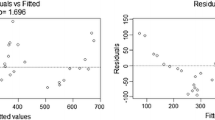Abstract
PLS (Partial Least Squares) regression is a model for situations where a low observation/variable ratio comes with highly collinear predictors. A comparison with other statistical methods can be found in Frank and Friedman (1993). The PLS method, very popular in chemometrics, has been generalized in several ways in order to extend PLS into nonlinearity. The first one (Wold et al., 1989) replaces the standard regression of the Y response matrix on the latent variable t with a quadratic model. The second one (Frank, 1990) uses a smooth nonlinear function of the latent variable through the SMART regression (Friedman, 1984).
Access this chapter
Tax calculation will be finalised at checkout
Purchases are for personal use only
Preview
Unable to display preview. Download preview PDF.
Similar content being viewed by others
References
Durand, J.F. (1993). Generalized principal component analysis with respect to instrumental variables via univariate spline transformations. Computational Statistics Data Analysis, 18, 423–440.
Frank, I.E. (1990). A nonlinear PLS model. Chemometrics and Intelligent Laboratory Systems, 8, 109–119.
Frank, I.E., Friedman, J.H. (1993). A statistical view of some Chemometrics regression tools (with discussion). Technometrics, 2, 109–148.
Friedman, J.H. (1984). SMART users guide. Tech. Rept. 1, LCS. Dept. of Statistics, Stanford University, Stanford, CA, USA.
Wold, S., Kettaneh-Wold, N. and Skagerberg, B. (1989). Nonlinear PLS modeling. Chemometrics and Intelligent Laboratory Systems, 7, 53–65.
Wright, G.E., Gambino, J.J. (1984). Quantitative structure-activity relationships of 6-anilinouracils as inhibitors of Bacillus subtilis DNA polymerase III. Journal of Medical Chemistry, 27, 181–185.
Author information
Authors and Affiliations
Editor information
Editors and Affiliations
Rights and permissions
Copyright information
© 1994 Springer-Verlag Berlin Heidelberg
About this paper
Cite this paper
Durand, JF., Sabatier, R. (1994). PLS Regression via Additive Splines. In: Dutter, R., Grossmann, W. (eds) Compstat. Physica, Heidelberg. https://doi.org/10.1007/978-3-642-52463-9_56
Download citation
DOI: https://doi.org/10.1007/978-3-642-52463-9_56
Publisher Name: Physica, Heidelberg
Print ISBN: 978-3-7908-0793-6
Online ISBN: 978-3-642-52463-9
eBook Packages: Springer Book Archive




